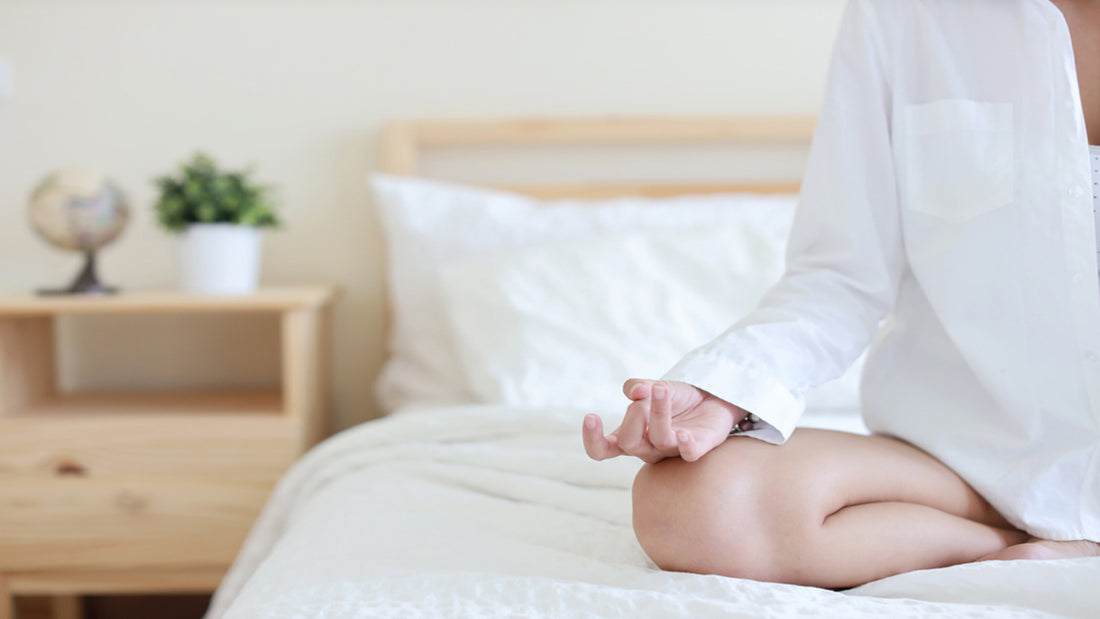
There are many forms of meditation in the world, everything from mantra meditation to visualization. Yet, if you looked at these different people meditating many of them would look quite similar. Why is this? Whether someone is chanting “om,” repeating positive affirmations, or staying silent and focusing on mindfulness, there are some basic elements of the meditation posture that are adhered to. This is done in order to calm the mind and align the body. This is known as the “Seven-Point Meditation Posture.”
First Point of Posture: Sitting Down
There are a few variations on sitting cross-legged on the ground, but all of them are best supported by having either a meditation cushion or supportive pillow. Sit on your meditation seat with your legs loosely crossed and both feet resting below the opposite thigh or knee. If you cannot sit with your legs crossed, that’s okay. Just sit with both feet laying on the floor in this relaxed position. This doesn’t mean your whole body is relaxed, though!
Second Point of Posture: Elongate the Spine
This brings us to the second point. You want to feel uplifted when you sit down to meditate. You are not slouched just because you’re sitting. Traditional analogies say that your spine should be like an arrow or a stack of coins, with one vertebra on top of the other. You should feel as if a rod could go through the top of your head and down through your bottom.
Third Point of Posture: Resting Your Hands
Next, it is time to place your hands. The simplest thing to do with your hands is to rest them on your lap. Drop them palms down on your thighs. This is a natural axis point on which to rest them, providing better support for your upright spine. You have certainly seen yogis and people meditating with their thumbs lightly touching the index finger, which is an option that is said to generate body heat and keep you more awake.
Fourth Point of Posture: Relaxing the Shoulders
It would be a mistake to think you should be sitting in a rigid stance in order to align your spine properly. In fact, your shoulders should be relaxed. Let the muscles in your shoulders relax, even push them slightly back. This establishes a strong back while “opening up” the front of the body.
Fifth Point of Posture: Tucking in the Chin
You must now direct your head. To do so, slightly tuck in your chin. You don’t want to go so far that you are looking directly down at your lap, but you don’t want your head held so far upwards that it may tire you out to old the same position. Your head is heavy on your neck and it must be resting comfortably so it doesn’t cause you neck pain.
Sixth Point of Posture: Opening the Jaw
If you’re like many people, you probably tense your jaw much more often than you realize. In order to properly meditate, bring a sense of relaxation to the muscles in your face so that your jaw hangs open. Don’t let your tongue hang out, of course. Place the tongue up against the roof of your mouth. This will allow for a clear, slow breathing and swallowing process.
Seventh Point of Posture: Resting the Gaze
Shouldn’t you close your eyes to meditate? Actually, no. Relax your gaze two to four feet ahead of you on the ground in an unfocused manner. Don’t look at your dog, watch the clock, focus on a stain, or count the patterns in the rug in front of you. Just maintain a loose gaze. Spiritually, we are always gazing at our world, so why should we treat our meditation practice as a time to hide from our life? It is instead a time to look directly at who we are, which means eyes being open. On a practical level, you are less likely to fall asleep with your eyes open.
According to those who dedicate their lives to this practice, if you take the time to establish your meditation posture correctly, you will find it is much easier to rest your mind. When you go through these seven points you will enter your practice feeling relaxed, and leave it feeling connected and uplifted. So, what happens if you don’t adhere to this? Will your nightly meditation efforts suffer if you hunch over? Your back certainly will!
Another way to think of posture is by calling it your “spinal alignment.” You want your head, neck, and back to all be positioned in a way that is healthy and comfortable. Proper alignment of your body puts less stress on the spine. Sitting in the incorrect position is going to cause pain that will make it difficult to sleep. You’ll want to do several things to remedy the situation if you are experiencing lower back, shoulder, or neck pain on a chronic basis. For one, really focus on your body’s position to ensure you are sitting correctly while meditating. You may be leaning too far forward to bending your spine without realizing it. If you aren’t yet sitting on a well-made pillow or cushion, this could also be the problem.
You may also want to consider a new mattress with better support so your body can rest and you will wake up revitalized. Your night of sleep is only as good at the materials you’re sleeping on, and PranaSleep can proudly say we deliver the best sleep- each and every night. Our luxury mattresses feature varying densities of our proprietary Talalay Latex to provide incredible support. We offer many choices, all of which feature comfort layers that conform to your body's individual contours. You’ll wake up pain free and ready to tackle another day with peace, gentleness, and mindfulness. A PranaSleep Mattress is like nothing you’ve ever experienced before!

